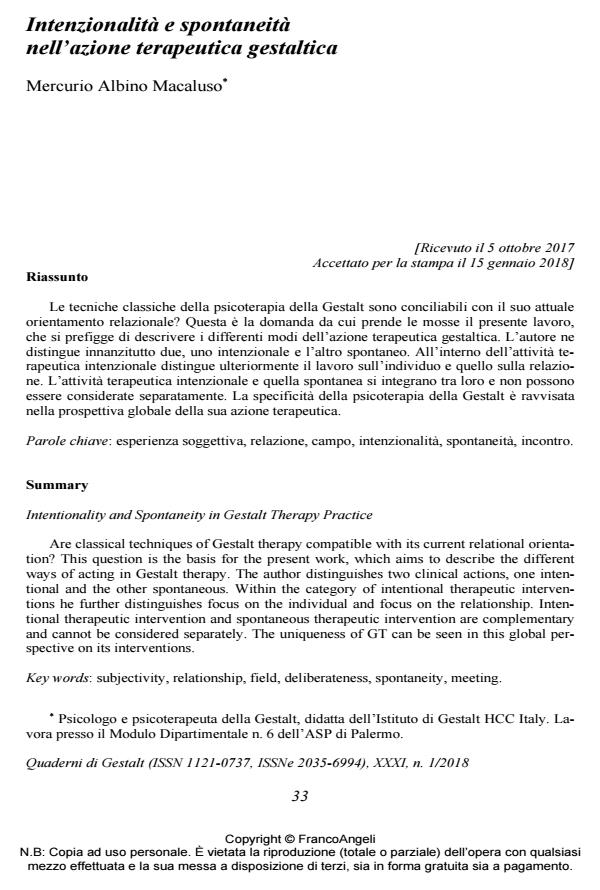Intentionality and Spontaneity in Gestalt Therapy Practice
Journal title QUADERNI DI GESTALT
Author/s Mercurio Albino Macaluso
Publishing Year 2018 Issue 2018/1
Language Italian Pages 25 P. 33-57 File size 238 KB
DOI 10.3280/GEST2018-001004
DOI is like a bar code for intellectual property: to have more infomation
click here
Below, you can see the article first page
If you want to buy this article in PDF format, you can do it, following the instructions to buy download credits

FrancoAngeli is member of Publishers International Linking Association, Inc (PILA), a not-for-profit association which run the CrossRef service enabling links to and from online scholarly content.
Are classical techniques of Gestalt therapy compatible with its current relational orientation? This question is the basis for the present work, which aims to describe the different ways of acting in Gestalt therapy. The author distinguishes two clinical actions, one intentional and the other spontaneous. Within the category of intentional therapeutic interventions he further distinguishes focus on the individual and focus on the relationship. Intentional therapeutic intervention and spontaneous therapeutic intervention are complementary and cannot be considered separately. The uniqueness of GT can be seen in this global perspective on its interventions.
Keywords: Subjectivity, relationship, field, deliberateness, spontaneity, meeting.
- Scrivere per elaborare il lutto. Un contributo della psicoterapia della Gestalt Marilena Senatore, in QUADERNI DI GESTALT 2/2024 pp.71
DOI: 10.3280/qg2024-2oa18094 - L'es in psicoterapia della Gestalt Mercurio Albino Macaluso, in QUADERNI DI GESTALT 1/2022 pp.47
DOI: 10.3280/GEST2022-001004 - Il caso di Michela: lo sguardo clinico di tre psicoterapeuti della Gestalt of Three Gestalt Psychotherapists Elisabetta Conte, Marilena Senatore, Maria Mione, Anna Ravenna, Stefano Rossi, in QUADERNI DI GESTALT 2/2021 pp.11
DOI: 10.3280/GEST2021-002002 - Il concetto di "campo" in psicoterapia della Gestalt. Sviluppi e implicazioni Mercurio Albino Macaluso, in QUADERNI DI GESTALT 1/2020 pp.57
DOI: 10.3280/GEST2020-001005 - L'intuito del terapeuta. Uno studio gestaltico sull'estetica della situazione terapeutica Margherita Spagnuolo Lobb, Febronia Riggio, Claudia Savia Guerrera, Federica Sciacca, in PSICOBIETTIVO 3/2024 pp.69
DOI: 10.3280/PSOB2023-003005 - Longevità, vitalità e sport in psicoterapia della Gestalt Salvatore Armando Cammarata, in QUADERNI DI GESTALT 2/2024 pp.65
DOI: 10.3280/GEST2023-002005
Mercurio Albino Macaluso, Intenzionalità e spontaneità nell’azione terapeutica gestaltica in "QUADERNI DI GESTALT" 1/2018, pp 33-57, DOI: 10.3280/GEST2018-001004